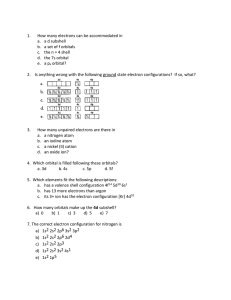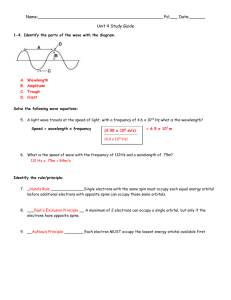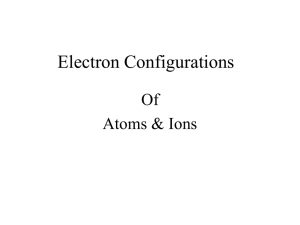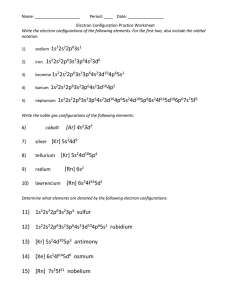Chapter 6 Electronic Structure of Atoms •
advertisement
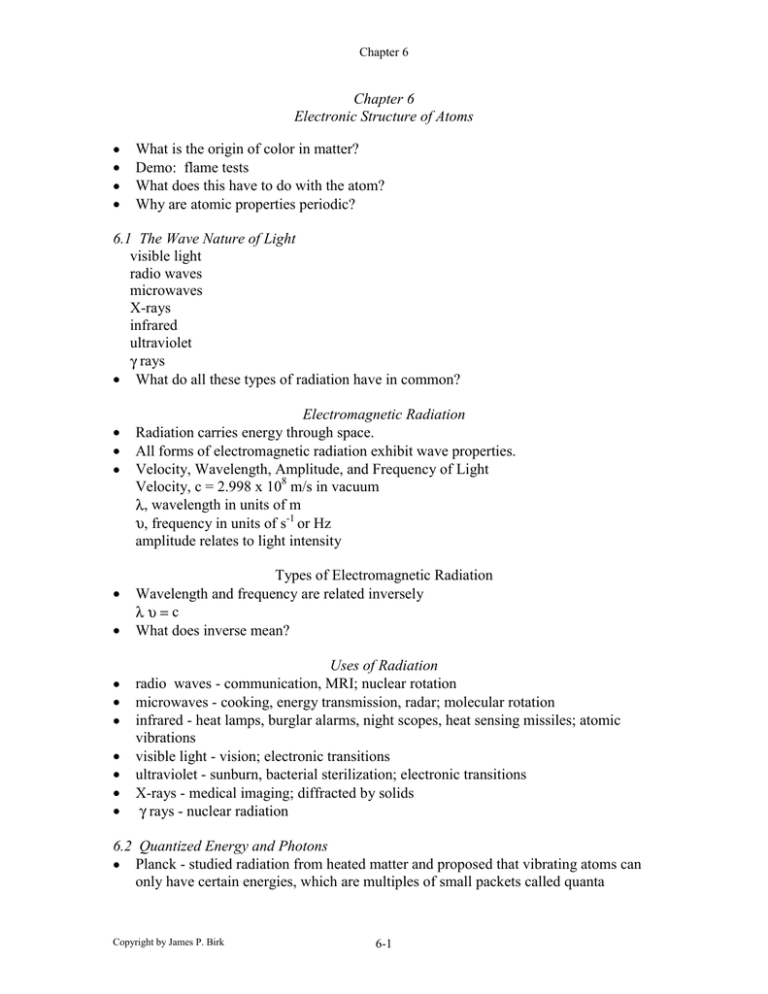
Chapter 6 Chapter 6 Electronic Structure of Atoms • • • • What is the origin of color in matter? Demo: flame tests What does this have to do with the atom? Why are atomic properties periodic? 6.1 The Wave Nature of Light visible light radio waves microwaves X-rays infrared ultraviolet γ rays • What do all these types of radiation have in common? • • • • • • • • • • • • Electromagnetic Radiation Radiation carries energy through space. All forms of electromagnetic radiation exhibit wave properties. Velocity, Wavelength, Amplitude, and Frequency of Light Velocity, c = 2.998 x 108 m/s in vacuum λ, wavelength in units of m υ, frequency in units of s-1 or Hz amplitude relates to light intensity Types of Electromagnetic Radiation Wavelength and frequency are related inversely λυ=c What does inverse mean? Uses of Radiation radio waves - communication, MRI; nuclear rotation microwaves - cooking, energy transmission, radar; molecular rotation infrared - heat lamps, burglar alarms, night scopes, heat sensing missiles; atomic vibrations visible light - vision; electronic transitions ultraviolet - sunburn, bacterial sterilization; electronic transitions X-rays - medical imaging; diffracted by solids γ rays - nuclear radiation 6.2 Quantized Energy and Photons • Planck - studied radiation from heated matter and proposed that vibrating atoms can only have certain energies, which are multiples of small packets called quanta Copyright by James P. Birk 6-1 Chapter 6 E = h υ or E = n h υ • Einstein - studied the emission of electrons from metals struck by light (photoelectric effect) and proposed that light must have some particle properties and that these “particles”, or photons, are quantized (can have only certain energy values: E = h υ) 6.3 Bohr’s Model of the Hydrogen Atom • Demo: wave interference Look at a bright light through a slit formed by holding your thumbs close together. This phenomenon is used to study matter. • • • • Interaction of Matter and Light Some radiation sources may emit only a single wavelength (e.g., a laser); called monchromatic Radiation that spans a whole array of wavelengths is called continuous Continuous radiation, such as visible light, can be separated into a spectrum, or sequence of colors by a prism or a diffraction grating. Demo: colors on CD Visible Spectrum • • • • • • • continuous spectrum Not all radiation sources produce a continuous spectrum. Line spectra are observed for elements, such as hydrogen Emission spectrum Demo: gas discharge tubes Why lines? Absorption spectrum Comparison of hydrogen absorption and emission spectra • • • • • • Hydrogen Spectrum Lines in visible region called the Balmer series λ = 364.56 n2/(n2-4), with n >2 and only integer values n = 3, λ = 656.2 nm n = 4, λ = 486.1 nm n = 5, λ = 434.1 nm n = 6, λ = 410.2 nm • • • • Other series of lines are observed in other ranges of wavelength (UV, IR) All are summarized by the Rydberg equation, λ-1 = R(n1-2 - n2-2), where the n1 and n2 are called quantum numbers Other elements gave other sets of lines How can we explain this behavior of atoms when they are heated or radiated? • Bohr's Model Rutherford showed that the atom contains a positively charged nucleus surrounded by Copyright by James P. Birk 6-2 Chapter 6 • • • • • • electrons Bohr wondered about what the electrons are doing in the atom. If they are stationary, they should fall into the nucleus, so they must be moving at tremendous speeds. But then why isn’t light emitted continuously and then why doesn’t the electron “run down” or lose its energy? Model of electrons in fixed orbits to explain quantization Transitions between orbits emits or absorbs light Bohr calculated the energy of the orbits to be En = -RH(1/n2) He introduced the idea that the energies of electrons in atoms were quantized -allowed only certain values, characterized by the principal quantum number, n Unfortunately, this idea only worked for atoms and ions that had but a single electron 6.4 The Wave Behavior of Matter • Does an electron behave like a particle or like a wave? Radiation appeared to behave sometimes like a wave and sometimes like a particle. What about electrons? • de Broglie - suggested that particles can have wavelike properties • wavelength is associated with particles; important only for atoms and subatomic particles Diffraction of Electrons and X-Rays • Davisson and Germer - found that electrons can be diffracted by solids just like Xrays • wave-particle duality • • • • • • • Diffraction of Electrons by Ice Just as light is diffracted by the grooves on a CD, a beam of electrons is diffracted by the planes of atoms in a crystal of ice. The Heisenberg Uncertainty Principle Bohr’s model works well only for atoms or ions with no more than 1 electron! Thus, the model cannot be correct! Attempts to fix the theory for multielectron atoms, such as using elliptical orbits, failed. Heisenberg found further that it is not possible to specify the structure as precisely as Bohr attempted to do. Impossible to know both the position and velocity (or energy) of an electron precisely. In order to “see” the position of an electron, we must probe it with radiation, which changes its position or velocity or both. Best we can do is specify the probability of finding an electron at a given point in space. A map of the region of highest probability is called an orbital. 6.5 Quantum Mechanics and Atomic Orbitals • Schrodinger developed a mathematical method called wave mechanics that brought all these ideas together. • A mathematical equation called a wave function is used to describe the energy of the Copyright by James P. Birk 6-3 Chapter 6 • electrons, which must be quantized. The square of the wave function gives the probability of finding the electron at any point in space, producing a map of the orbital. • Atomic Orbitals From the square of the wave function, we get the probability density, the probability that the electron will be in a given region of space Orbitals and Quantum Numbers • The Principal Quantum Number, n • correlates with average distance of the electron from the nucleus • values of 1, 2, 3, 4, … • called shells, which differ in energy • The Azimuthal Quantum Number, l • correlates with shape of the orbital where the electron is found; labeled s, p, d, f; called subshells • values of 0,…,n-1 set of orbitals with the same values of n and l are called a subshell • The Magnetic Quantum Number, ml • • correlates with the orientation of the orbital; each orbital in a subshell points in a different direction • values of -l,…,0,…l The Spin Quantum Number, ms • • correlates with the spin of the electron • values of +1/2, -1/2 • Orbital Energy Levels in Hydrogen In hydrogen atoms, electrons have the same energy in any orbital with the same value of the principal quantum number. Note that this is not true for other elements. 6.6 Representations of Orbitals • Electron density distributions give us information about the shapes and orientations of orbitals. Here we see the graphs for the s orbitals. • The s orbitals are all spherical. Note the nodes in the 2s and 3s orbitals. These correspond to areas where there is low probability of finding an electron. • As the value of n increases, the electron is more likely to be found further from the nucleus. Thus, these s orbitals differ in size. Represent 90% probability as hard spheres. Shapes of Orbitals • Orbitals have different shapes • Describe the motion of an electron in an orbital. • Sets of Orbitals (Subshells) Depending on the type of orbital, we find that they occur in sets differing in their orientation in space; in a magnetic field the lines in the hydrogen spectrum split into Copyright by James P. Birk 6-4 Chapter 6 • • • • • • • • • • • more lines s - set of 1 p - set of 3 d - set of 5 f - set of 7 Shorthand Notation for Orbitals Combinations of first two quantum numbers; number of orbital types equals the shell number (n). 1s 2s, 2p 3s, 3p, 3d 4s, 4p, 4d, 4f 5s, 5p, 5d, 5f, (5g) 6s, 6p, 6d, 6f, (6g, 6h) 6.7 Orbitals in Many-Electron Atoms • Properties of atoms correlate with the number and energy of electrons • Electron configurations are used to summarize the distribution of electrons among the various orbitals • Many-electron atoms have orbitals with the same shape as hydrogen, but the energies are different because of electron-electron repulsions. • • • • • • • • Effective Nuclear Charge Electrons are all attracted to the nucleus, but repel one another. The effective nuclear charge is smaller than the charge of the nucleus because an electron is repelled by other electrons closer to the nucleus, which shield or screen it from the nucleus (screening effect). This effect changes the energy of the outer electrons. s orbitals penetrate closer to the nucleus than p orbitals, which penetrate closer than d orbitals Thus s electrons experience a greater effective nuclear charge than p orbitals, which experience a greater effective nuclear charge than d orbitals. This leads to a separation of the energies of the orbitals in a shell. Aufbau Principle Aufbau Principle: start with the nucleus and empty orbitals, then “build” up the electron configuration using orbitals of increasing energy Add electrons to orbitals in order of increasing energy ns < (n-2)f < (n-1)d < np Electron Spin and Pauli Exclusion Principle Pauli Exclusion Principle: no two electrons can have the same values of all 4 quantum numbers Thus only two electrons can occupy a single orbital and they must have opposite spins Copyright by James P. Birk 6-5 Chapter 6 6.8 Electron Configurations • Arrangement of electrons in the orbitals is called the electron configuration of the atom • The ground state configuration can be predicted, using the Aufbau Principle, the Pauli Exclusion Principle, and Hund’s Rule. • Hund's Rule: when filling a subshell, such as the set of 3 p orbitals, place 1 electron in each before pairing up electrons in a single orbital • • • • • • • Electron Configurations How do we know about the order of filling orbitals? Paramagnetism: unpaired electrons can be measured by interaction with a magnetic field; the greater the number of unpaired electrons, the stronger the material interacts with a magnetic field Demo: interaction of MnOn with a magnet Demo: Ferromagnetic Fluids Color arises from electrons shifting from one orbital to another of different energy Ground state and excited state What shift would give rise to emission of light? to absorption of light? Electron Configurations of Some Atoms See the first ten elements • 1s1 1s2 1s2 2s1 1s2 2s2 1s2 2s2 2p1 1s2 2s2 2p2 1s2 2s2 2p3 1s2 2s2 2p4 1s2 2s2 2p5 1s2 2s2 2p6 • Group work: What are the configurations of the next elements? • Some exceptions to the Aufbau order: Cr 1s2 2s2 2p6 3s2 3p6 4s1 3d5 Cu 1s2 2s2 2p6 3s2 3p6 4s1 3d10 • What is the expected order? • Filled and half-filled subshells seem to be especially stable. 6.9 Electron Configurations and the Periodic Table • Valence electron configurations repeat down a group • What is the electron configuration of atoms of the following elements? • sulfur • aluminum • fluorine Copyright by James P. Birk 6-6 Chapter 6 • • oxygen scandium Valence Electrons • • • • • • • • • • • • • Electrons in the outermost shell 1s2 2s2 2p6 1s2 2s2 2p6 3s2 3p5 1s2 2s2 2p6 3s2 3p6 4s2 3d4 What are the valence electrons in the following configurations? 1s2 2s2 2p6 3s2 1s2 2s2 Electron Configurations of Monatomic Ions Anions - simply continue to add electrons in the Aufbau order Write the electron configuration of F– O2– N3– These ions are called isoelectronic. Cations - simply remove electrons in the reverse of the Aufbau order Write the electron configuration of Al3+ Mg2+ Na+ These ions are isoelectronic. Transition metal cations - remove electrons from the ns orbital first, then in the reverse of the Aufbau order Write the electron configuration of Cr2+ Ti3+ Fe3+ Copyright by James P. Birk 6-7

